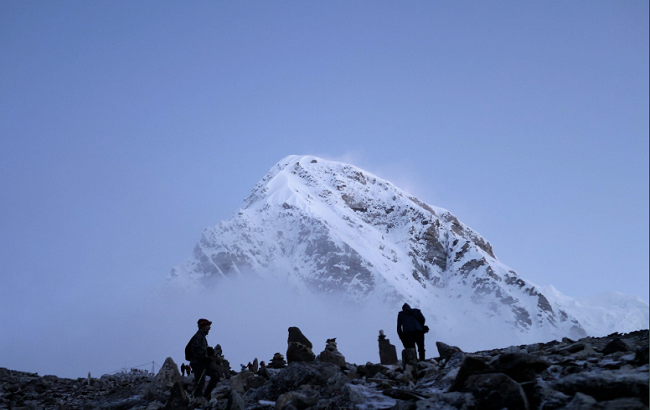
Combien de temps pour monter l’Everest : 5 défis incroyables et inspirants à surmonter
Patricia Mary January 26, 2025 ArticleClimbing Mount Everest, the highest peak in the world, is an experience that many mountaineers and adventurers dream of. However, “Combien de temps pour monter l’Everest?” is a question that is asked by many as they prepare for this daunting expedition. The journey to Everest’s summit can take several weeks, sometimes up to two months, depending on various factors like weather, physical endurance, and acclimatization. In this article, we will explore five incredible and inspiring challenges climbers face on their journey, including the time it takes to reach the summit and the physical and mental hurdles they must overcome along the way.
Table of Contents
ToggleCombien de temps pour monter l’Everest? The Basic Timeline of Climbing Everest
Before we dive into the challenges climbers face, it’s important to have a basic understanding of the timeline for climbing Mount Everest. As mentioned, the climb typically takes around two months. This period can vary depending on the weather conditions, the climbers’ physical condition, and other factors.
Key stages of the climb include:
- The Trek to Everest Base Camp: A 10-day trek to Everest Base Camp (EBC).
- Acclimatization Process: A few weeks spent getting used to the high altitudes.
- Summiting the Peak: A final push to the summit that takes 6-8 hours.
- Descent: Another few days or weeks to descend safely.
1. Combien de temps pour monter l’Everest? The Trek to Everest Base Camp
The journey to Mount Everest begins with a trek to Everest Base Camp (EBC). This part of the expedition usually takes about 8 to 10 days, depending on the pace and weather conditions. The trek is not just a walk; it’s an ascent through a rugged landscape at increasing altitudes, which can be physically taxing for many climbers.
During this phase, climbers traverse through several Sherpa villages like Namche Bazaar, which is often referred to as the gateway to Everest. It’s a busy town where climbers take a few days to acclimatize before continuing their trek. Along the way, the views become increasingly breathtaking, with stunning vistas of Everest, Lhotse, and Ama Dablam—just some of the towering peaks in the area.
Key Highlights of the Trek to Base Camp:
- The trek starts at Lukla Airport, a small airport with a runway perched on a mountain.
- Climbers pass through famous villages like Phakding and Tengboche, with panoramic views of Everest and other surrounding peaks.
- Namche Bazaar is the primary stop for acclimatization before heading to higher altitudes.
- The trek is physically demanding, with steep climbs and rapidly increasing altitudes.
This stage of the climb is crucial, as climbers need to adjust their bodies to the higher altitude gradually. It is not uncommon for climbers to feel out of breath or fatigued during this phase, especially in the first few days.
2. Combien de temps pour monter l’Everest? The Acclimatization Process
One of the most challenging and important aspects of climbing Everest is acclimatization. At sea level, oxygen levels are plentiful, but as climbers ascend, the air becomes thinner. At the summit of Everest, oxygen levels are only around 33% of what they are at sea level, making it incredibly difficult to breathe and perform basic tasks. This makes proper acclimatization essential for climbers’ safety and success.
Acclimatization can take anywhere from 4 to 6 weeks, during which climbers gradually ascend to higher camps and then return to lower elevations to rest. This process helps the body adjust to the lower oxygen levels. Without proper acclimatization, climbers risk developing altitude sickness, which can be fatal.
Acclimatization Strategy:
- Climbers typically ascend to Camp I (6,065 meters), then return to Base Camp to rest and recover.
- After a few days of rest, climbers ascend to Camp II (6,400 meters) and again descend to Base Camp to allow their bodies to adjust.
- They will repeat this pattern, progressively ascending higher and staying longer at each camp to prepare for the summit push.
Many climbers also use a method known as climbing high and sleeping low to aid the acclimatization process. This method helps the body adjust by exposing it to higher altitudes during the day while resting at lower altitudes during the night.
Why Acclimatization is Crucial:
- Without proper acclimatization, climbers are at high risk of altitude sickness, which can cause symptoms like headaches, dizziness, and nausea.
- As the body adapts to the lower oxygen levels, it produces more red blood cells, which helps improve oxygen efficiency at high altitudes.
For those planning to climb Everest, proper acclimatization is vital, and it is best done under the guidance of experienced sherpas or guides. If you’re interested in more in-depth acclimatization tips, visit Silktest.org.
3. Combien de temps pour monter l’Everest? Physical and Mental Endurance
Climbing Mount Everest is no small feat. It requires not only physical strength but also an immense amount of mental toughness. The physical demands of Everest can break even the most seasoned climbers, as the thin air makes every step feel like an enormous effort. To make matters worse, climbers often deal with extreme weather conditions, which can make even the simplest task incredibly challenging.
Physical Endurance Challenges:
- Oxygen Deprivation: As you ascend, the lack of oxygen makes even basic movements exhausting. Climbing at altitudes higher than 8,000 meters (the “death zone”) requires climbers to use supplemental oxygen to function properly.
- Exhaustion: The long days, high altitudes, and extreme conditions take a toll on the body, leaving climbers drained and sometimes physically incapacitated.
- Freezing Temperatures: The cold is another enemy. At higher altitudes, temperatures can drop below -60°C (-76°F), requiring climbers to wear multiple layers of specialized clothing to prevent frostbite.
While physical endurance is tested to its limits, mental endurance is just as important. The climb to the summit requires focus, determination, and the ability to endure suffering. The mental strain often makes climbers question their ability to reach the summit, especially when dealing with extreme cold, pain, and exhaustion.
Tips for Physical and Mental Endurance:
- Train rigorously before the expedition by doing endurance exercises and strength training.
- Stay positive and set small goals during the climb to stay motivated.
- Take regular breaks and drink plenty of fluids to prevent dehydration and exhaustion.
At the end of the day, Everest isn’t just about strength; it’s about having the mental fortitude to push through difficult times.
4. Combien de temps pour monter l’Everest? The Summit Push
After weeks of acclimatization and preparation, climbers make the final push toward the summit. This stage is undoubtedly the most challenging part of the entire climb. The final ascent typically takes 6-8 hours, and it is often done during the early morning hours to avoid bad weather in the afternoon.
At this point, climbers must contend with both the physical and mental toll that the past weeks have had on their bodies. The air is thinner than ever, and the temperature can be bitterly cold. Many climbers, at this stage, are on supplemental oxygen and are moving slowly due to fatigue.
The Summit Push Process:
- Climbers start their summit bid from Camp IV (7,900 meters) around midnight or early morning to make the ascent in relatively better weather conditions.
- The Hillary Step, a notorious rock face, poses one of the most significant obstacles just below the summit. It is a challenging section that requires both technical climbing skills and a great deal of strength.
- Once the summit is reached, climbers are often overwhelmed with emotion, but the climb is far from over. The descent still needs to be completed.
Tips for the Summit Push:
- Stay focused on your goal and avoid any unnecessary distractions.
- Move steadily, don’t rush, and save energy for the final stages.
- Use supplemental oxygen and take it easy when needed.
5. Combien de temps pour monter l’Everest? The Descent and Final Return
Once the summit is reached, the job is far from finished. The descent can take as long as the climb up, and climbers must be incredibly careful during this phase. Fatigue can set in after hours of intense exertion, and at high altitudes, the risks of falling or making mistakes are elevated.
Key Considerations for the Descent:
- Climbers descend from the summit and make their way back to Camp IV before heading down to lower camps.
- The descent is often more dangerous than the ascent, as climbers may be physically exhausted and less alert.
- It can take several days to descend all the way back to Base Camp.
Even though climbers are now off the summit, they still need to deal with the lingering effects of altitude sickness, and their bodies will continue to suffer from exhaustion until they reach lower altitudes. Rest and recovery are critical to ensure climbers make it back to Lukla and ultimately return home safely.
Conclusion: Combien de temps pour monter l’Everest?
In conclusion, climbing Mount Everest is a monumental challenge that takes around two months to complete, with several stages to go through. The entire climb requires careful preparation, physical stamina, and mental toughness. Climbers must face several challenges, such as the trek to Base Camp, acclimatization, the summit push, and the descent.
If you’ve asked yourself, Combien de temps pour monter l’Everest?, you now know that it’s not just about how much time it takes but about the incredible resilience and determination needed to conquer the world’s tallest mountain. It’s not a journey for the faint of heart, but for those who are truly determined, the summit awaits.
FAQ
Q1: Combien de temps pour monter l’Everest?
It typically takes around 2 months to climb Everest, including the trek, acclimatization, summit push, and descent.
Q2: What is the hardest part of climbing Mount Everest?
The hardest parts are acclimatization and the summit push, which require both physical and mental endurance.
Q3: Can beginners climb Mount Everest?
Climbing Everest requires significant mountaineering experience. It is not recommended for beginners.
Q4: When is the best time to climb Mount Everest?
The best times are April-May and October-November, when the weather is most stable.
Q5: How dangerous is climbing Everest?
Climbing Everest is highly dangerous due to altitude sickness, extreme weather, and the difficult terrain. Proper preparation is essential.
You May Also Like:
You may also like
Archives
Calendar
| M | T | W | T | F | S | S |
|---|---|---|---|---|---|---|
| 1 | 2 | 3 | 4 | 5 | 6 | |
| 7 | 8 | 9 | 10 | 11 | 12 | 13 |
| 14 | 15 | 16 | 17 | 18 | 19 | 20 |
| 21 | 22 | 23 | 24 | 25 | 26 | 27 |
| 28 | 29 | 30 | 31 | |||

Leave a Reply